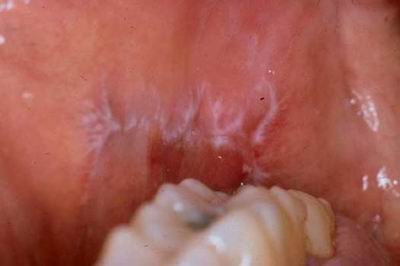Lichen Planus Information
Click here to scroll to the list of available medications ↓
Lichen planus is most often defined as an oral disease that affects the lining of the mouth with inflammation. Most patients come down with their first case between the age of 45 and 60, although a slowly increasing number of reports dealing with younger patients have trickled in. While lichen planus is most often associated with the interior of the cheeks, many cases will find the entire mouth is affected, including the gums, the tongue, the lips, and in rare cases, the throat or esophagus. Women are much more susceptible to lichen planus than men, although the reason for this is pure speculation. Lichen planus also occurs on the skin, as a skin disease, and often must be referred to specifically as skin lichen planus to differentiate between the oral type.
Lichen planus is a self contained disease that can last for weeks, months, and in some cases, years. It is not contagious. It is often mistaken for genital diseases, as the genitalia are often the most noticeably affected during the early development stage. Because the symptoms and outbreaks occur rapidly and then disappear, often for weeks, treatment is difficult. While some patients find great relief in cool compresses or tub soaks and cool baths, most patients require medical treatment in order to relieve their symptoms.
Lichen planus is most often recognized as a rash that irritates the wrists, ankles, forearms, and the mucous membranes of the genitals. The neck, lower back, nails, nostrils, and scalp are also commonly attacked as the rash progresses.
The rash itself appears to be bumps which are flat on the top and may be any shade of pink, red, or purple. The itching associated with lichen planus can be extreme. When the mucous membranes are involved, it is not uncommon for them to combine the sensation of itch with a powerful burning sensation. When the finger or toe nails are involved the nails will often split, become grooved, and thin which often results in the loss of the nail. The hair on the scalp may thin or begin to fall out as the redness and irritation along the top of head continues to persist.
Even after treatment and the pain and itching has subsided, a lingering presence of altered pigment may remain on the skin for months, usually a gray or purplish looking spot where there was once a mark of the original hive.

Few cases have been linked to a direct cause. Hepatitis C, infections, illness, and medication reactions have been linked to less than 10% of known cases. The remaining percentage has no indication of cause.
Diagnosis of lichen planus is relatively simple. The rash is difficult to confuse with other rashes, and its distinct nature makes it nearly diagnosable by sight alone. However, patients should be interviewed to understand the circumstance and the length of presence as the rash is concerned, and visual diagnosis should always be followed up via a skin biopsy.
There are few complications resulting from lichen planus. The most common complication is an infection of the skin acquired by vigilant scratching. A very small percentage find that after a long term battle with lichen planus, their cells become cancerous, thus skin cancer is a realistic but rare risk. Tobacco products are highly discouraged for cases like these, as tobacco raises the natural levels of risk associated with skin cell carcinoma.
Treatment options vary. For some, chronic cooling compresses and baths are the only relief they ever really find, despite treatment. There are cases that are just too stubborn and very strong strains of lichen planus developing. Other indications, in less severe cases, might rely on antihistamines for relief. Corticosteroids have been satisfactorily prescribed for severe cases, but it is more common to treat cases with phototherapy using ultraviolet light. Most physicians will immediately prescribe steroid-sparing-immune-modulating medications, which come in a topical form and are applied directly to the affected areas. It is not uncommon for patients to struggle for years in an attempt to get the lichen planus under control.
Over the counter antihistamines can often help with the significant itching associated with lichen planus. When patients use an over the counter ointment, the ointment should contain a minimum 1% hydrocortisone cream. Many patients rely on the varying self soothing methods mentioned earlier to help care for themselves while battling lichen planus.